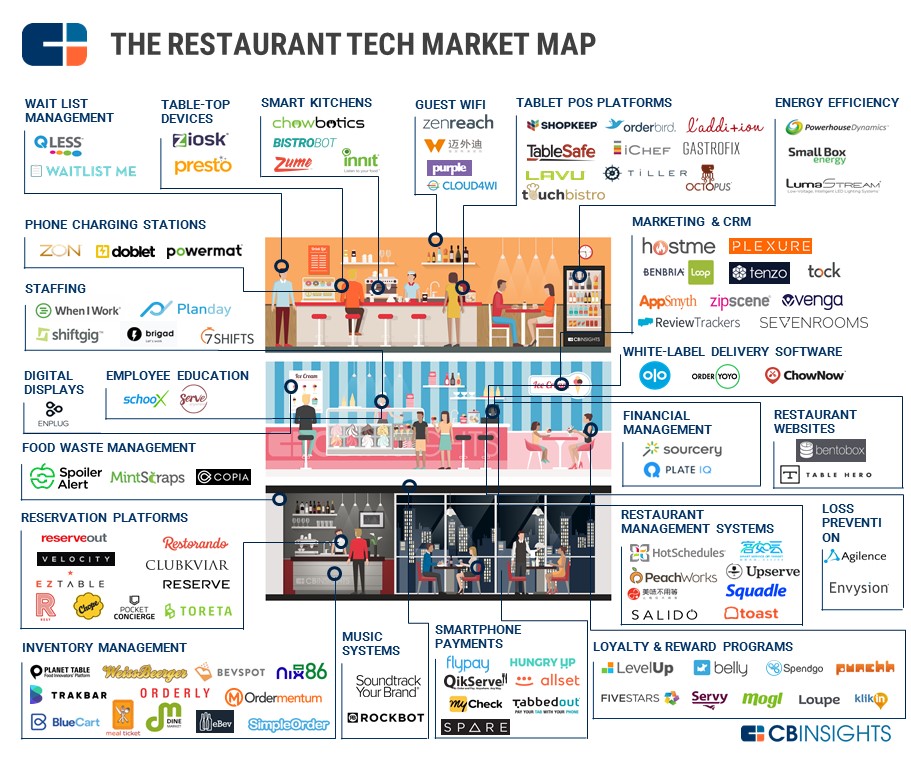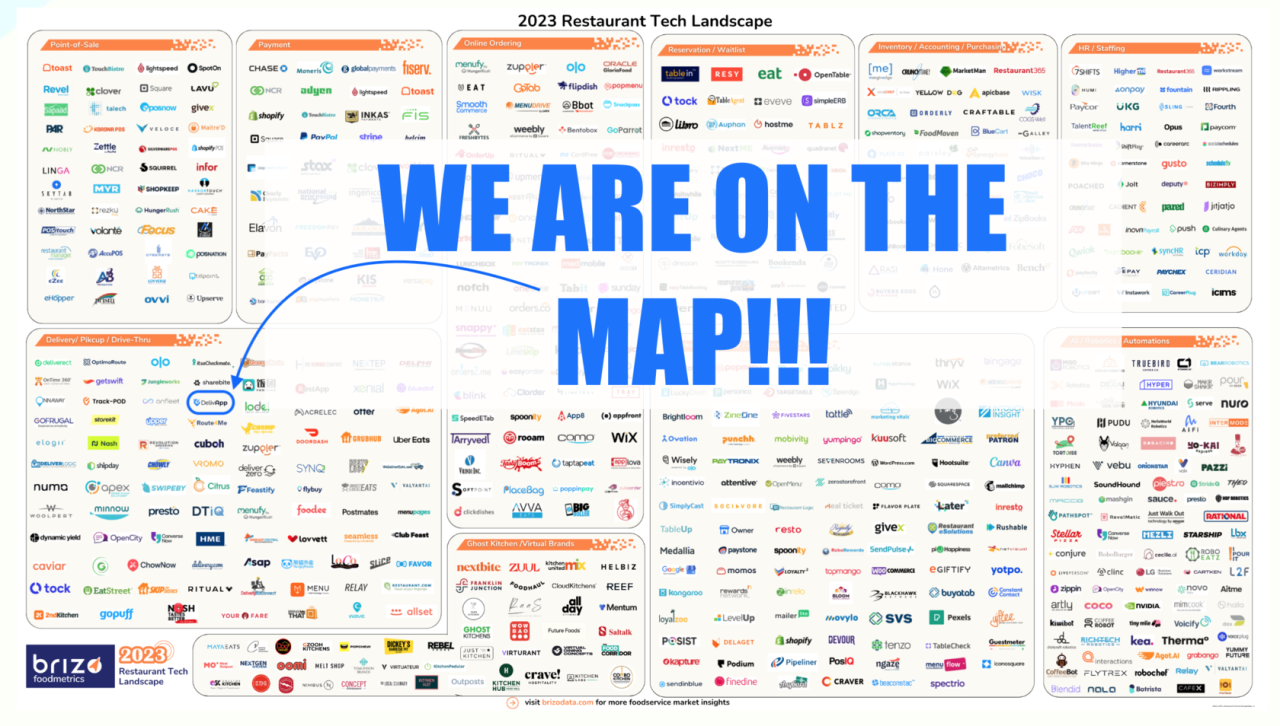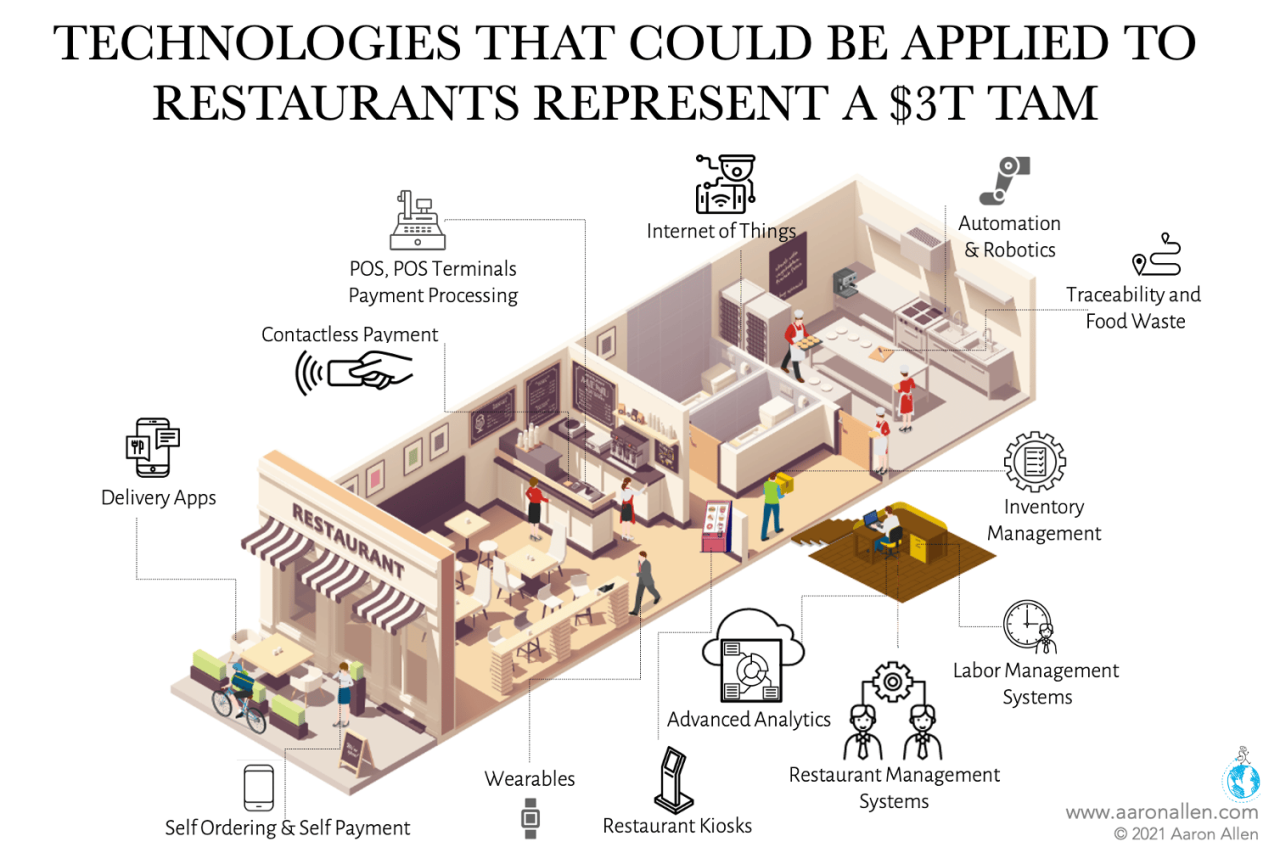Restaurant Technology Companies: Shaping the Future of Dining
Restaurant technology companies are revolutionizing the way we eat, transforming both the dining experience and the restaurant industry itself. From sleek point-of-sale systems to sophisticated online ordering platforms, these companies […]

Restaurant technology companies are revolutionizing the way we eat, transforming both the dining experience and the restaurant industry itself. From sleek point-of-sale systems to sophisticated online ordering platforms, these companies are equipping restaurants with the tools they need to thrive in today’s competitive market.
The rise of restaurant technology has been driven by several key factors, including the increasing demand for convenience, the growing popularity of mobile ordering and delivery, and the need for restaurants to optimize their operations and enhance customer satisfaction. This technology is not just about efficiency; it’s about creating a more personalized and enjoyable dining experience for customers.
The Restaurant Technology Landscape

The restaurant technology market is rapidly evolving, driven by factors such as the rise of online ordering, the increasing demand for contactless experiences, and the need for greater operational efficiency. These advancements are transforming how restaurants operate, interact with customers, and manage their businesses.
Key Trends Shaping the Restaurant Technology Market
The restaurant technology market is experiencing a surge in innovation, driven by several key trends. These trends are shaping the industry landscape and influencing how restaurants approach technology adoption.
- Mobile Ordering and Delivery: The rise of mobile ordering and delivery platforms has significantly altered consumer behavior. Customers now expect seamless online ordering and fast delivery options, pushing restaurants to invest in technology that facilitates these services.
- Contactless Experiences: The COVID-19 pandemic accelerated the adoption of contactless experiences, including online ordering, mobile payments, and self-service kiosks. This trend is expected to continue as consumers prioritize safety and convenience.
- Data Analytics and Insights: Restaurants are leveraging data analytics to gain insights into customer preferences, menu performance, and operational efficiency. This data-driven approach helps them make informed decisions and optimize their operations.
- Artificial Intelligence (AI): AI is being integrated into various restaurant technologies, from chatbot-based customer service to automated inventory management. AI can help restaurants personalize customer experiences, optimize pricing, and improve operational efficiency.
Major Categories of Restaurant Technology Solutions
Restaurant technology solutions cater to various aspects of restaurant operations, from managing orders and payments to enhancing customer experiences. Here are some of the major categories of restaurant technology solutions:
- Point of Sale (POS) Systems: POS systems are the backbone of restaurant operations, enabling order taking, payment processing, inventory management, and reporting. Modern POS systems are cloud-based, offering features like online ordering, table management, and customer loyalty programs.
- Online Ordering and Delivery Platforms: Platforms like DoorDash, Uber Eats, and Grubhub connect restaurants with customers who want to order food online and have it delivered. These platforms offer restaurants access to a wider customer base and streamline delivery operations.
- Customer Relationship Management (CRM): CRM systems help restaurants manage customer interactions, track preferences, and personalize marketing efforts. They can help restaurants build customer loyalty and drive repeat business.
- Inventory Management Systems: Inventory management systems help restaurants track their stock levels, manage supplier relationships, and minimize waste. These systems can optimize ordering processes and ensure that restaurants always have the necessary ingredients on hand.
- Kitchen Display Systems (KDS): KDSs streamline kitchen operations by displaying orders in real-time, helping chefs manage orders efficiently and reduce wait times. Modern KDSs can integrate with POS systems and online ordering platforms.
Leading Players in Restaurant Technology
The restaurant technology market is highly competitive, with numerous players offering innovative solutions. Here are some of the leading players in each category:
Point of Sale (POS) Systems
- Toast: Toast is a cloud-based POS system that offers a comprehensive suite of features, including online ordering, table management, and customer loyalty programs.
- Square: Square is a popular POS system known for its ease of use and affordable pricing. It offers features like online ordering, inventory management, and customer analytics.
- Lightspeed: Lightspeed is a cloud-based POS system that caters to various industries, including restaurants. It offers features like online ordering, table management, and employee scheduling.
Online Ordering and Delivery Platforms
- DoorDash: DoorDash is one of the largest food delivery platforms, connecting restaurants with customers in various cities worldwide.
- Uber Eats: Uber Eats is another popular food delivery platform, offering restaurants access to a large customer base and delivery services.
- Grubhub: Grubhub is a leading online food ordering platform that connects customers with restaurants in various cities.
Customer Relationship Management (CRM)
- Zomato: Zomato is a global restaurant search and discovery platform that also offers CRM features for restaurants.
- OpenTable: OpenTable is a popular restaurant reservation platform that also offers CRM features to help restaurants manage customer relationships.
- Yelp: Yelp is a well-known online review platform that also offers CRM features for restaurants, allowing them to manage customer interactions and track reviews.
Inventory Management Systems
- ChefHero: ChefHero is a cloud-based inventory management system that helps restaurants optimize ordering, reduce waste, and improve profitability.
- Orderhive: Orderhive is a comprehensive inventory management system that caters to various industries, including restaurants. It offers features like order tracking, supplier management, and warehouse optimization.
- Vend: Vend is a POS and inventory management system that helps restaurants manage their inventory, sales, and customer data.
Kitchen Display Systems (KDS)
- Kitchen Display Systems (KDS): KDSs streamline kitchen operations by displaying orders in real-time, helping chefs manage orders efficiently and reduce wait times. Modern KDSs can integrate with POS systems and online ordering platforms.
- Orderly: Orderly is a cloud-based KDS that offers real-time order tracking, kitchen management tools, and reporting features.
- Revel Systems: Revel Systems is a POS and KDS solution that helps restaurants manage their operations, including order taking, kitchen management, and reporting.
Benefits of Restaurant Technology
In today’s fast-paced world, restaurant technology is no longer a luxury but a necessity. From streamlining operations to enhancing customer experiences, technology offers a plethora of advantages for both restaurants and their patrons.
Improved Operational Efficiency
Restaurant technology plays a crucial role in optimizing operational efficiency, enabling restaurants to run smoothly and effectively. By automating tasks and processes, technology frees up staff time for more customer-centric activities.
- Inventory Management: Restaurant technology can help restaurants track inventory levels, minimize waste, and optimize ordering. By using inventory management systems, restaurants can receive real-time updates on stock levels, set reorder points, and avoid stockouts. This not only saves money but also ensures that customers always have the desired menu items available.
- Order Management: Online ordering systems, point-of-sale (POS) systems, and kitchen display systems (KDS) streamline the order process, reducing errors and delays. POS systems allow staff to take orders quickly and accurately, while KDSs provide a clear view of orders in the kitchen, ensuring efficient food preparation and delivery.
- Staff Scheduling: Restaurant technology can help optimize staff scheduling, ensuring adequate staffing levels at all times. By analyzing historical data and predicting demand, scheduling systems can create efficient schedules that minimize labor costs and ensure sufficient coverage during peak hours.
- Financial Management: Restaurant technology can help track finances, manage payroll, and generate reports, providing valuable insights into restaurant performance. This allows owners and managers to make informed decisions regarding pricing, promotions, and resource allocation.
Enhanced Customer Experience
Restaurant technology empowers restaurants to provide exceptional customer experiences, leading to increased satisfaction and loyalty.
- Online Ordering and Delivery: Customers appreciate the convenience of ordering food online and having it delivered directly to their doorsteps. Online ordering platforms and delivery services provide a seamless experience, allowing customers to browse menus, place orders, and track delivery progress in real time.
- Table Management: Reservation systems and table management software allow customers to book tables online, eliminating the need for phone calls and walk-ins. This provides a more convenient and efficient dining experience, especially during peak hours.
- Personalized Recommendations: Restaurant technology can analyze customer data and provide personalized recommendations for dishes, drinks, and special offers. This enhances the dining experience by suggesting items that align with customer preferences, increasing the likelihood of repeat orders and positive reviews.
- Digital Menu Boards: Digital menu boards offer a dynamic and engaging way to showcase menu items, specials, and promotions. They can be easily updated to reflect changes in pricing, availability, and seasonal offerings, providing customers with up-to-date information.
Increased Revenue, Restaurant technology companies
By optimizing operations and enhancing customer experiences, restaurant technology can drive revenue growth.
- Increased Efficiency: Streamlined operations and reduced labor costs contribute to higher profit margins. By automating tasks and minimizing waste, restaurants can save money and increase their profitability.
- Expanded Reach: Online ordering and delivery services allow restaurants to reach a wider customer base, attracting new patrons who may not have visited the physical location.
- Improved Customer Loyalty: Exceptional customer experiences lead to increased satisfaction and loyalty, resulting in repeat business and positive word-of-mouth referrals.
- Data-Driven Decisions: Restaurant technology provides valuable data that can be used to make informed decisions regarding pricing, promotions, and menu offerings, leading to higher revenue and profitability.
Types of Restaurant Technology Companies
The restaurant technology landscape is vast and diverse, encompassing a wide range of companies specializing in various aspects of restaurant operations. These companies cater to the unique needs of restaurants, from managing orders and payments to optimizing operations and enhancing customer experiences.
Restaurant technology companies can be categorized based on their core offerings and areas of expertise.
Point of Sale (POS) Systems
POS systems are the backbone of modern restaurant operations, enabling businesses to manage orders, process payments, track inventory, and generate reports. POS providers offer hardware and software solutions tailored to the specific requirements of different restaurant types, from casual dining to fine dining.
Here are some examples of leading POS providers:
- Toast: Toast is a comprehensive POS system that integrates with online ordering, delivery, and loyalty programs, providing a unified platform for restaurant management.
- Square: Square offers a user-friendly POS system with mobile payment processing capabilities, ideal for smaller restaurants and food trucks.
- Lightspeed: Lightspeed provides a robust POS solution for restaurants of all sizes, with features such as inventory management, employee scheduling, and customer relationship management (CRM).
Online Ordering Platforms
Online ordering platforms allow customers to place orders directly from restaurant websites or mobile apps, streamlining the ordering process and expanding reach. These platforms often integrate with POS systems, enabling seamless order fulfillment and management.
Here are some examples of popular online ordering platforms:
- Grubhub: Grubhub is a leading online food ordering and delivery platform, connecting customers with a vast network of restaurants.
- DoorDash: DoorDash is another prominent online ordering and delivery service, offering a wide selection of restaurants and delivery options.
- Uber Eats: Uber Eats, part of the Uber transportation network, provides on-demand food delivery services from various restaurants.
Delivery Services
Delivery services facilitate the delivery of food from restaurants to customers, offering convenience and expanding reach. These services often partner with restaurants, providing logistics and customer support for deliveries.
Here are some examples of delivery services:
- Postmates: Postmates offers on-demand delivery services for food, groceries, and other items, partnering with a wide range of restaurants.
- Instacart: Instacart focuses primarily on grocery delivery, but also partners with restaurants for food delivery services.
- Caviar: Caviar specializes in delivering high-quality food from curated restaurants, focusing on a premium dining experience.
Data Analytics Companies
Data analytics companies provide tools and services to restaurants for collecting, analyzing, and interpreting data related to customer behavior, operations, and performance. This data can be used to optimize pricing, marketing, and menu offerings, enhancing profitability and customer satisfaction.
Here are some examples of data analytics companies:
- 7shifts: 7shifts provides labor management software that analyzes scheduling data, optimizes staffing, and helps restaurants reduce labor costs.
- Revel Systems: Revel Systems offers a comprehensive POS solution with advanced data analytics capabilities, enabling restaurants to track sales, inventory, and customer trends.
- OrderUp: OrderUp provides a platform for online ordering and delivery, with data analytics tools that help restaurants understand customer preferences and optimize their menu offerings.
Business Models
Restaurant technology companies employ various business models to generate revenue and sustain their operations.
Here are some common business models:
- Subscription-based: This model involves a recurring monthly or annual fee for access to software and services. Examples include POS systems, online ordering platforms, and data analytics tools.
- Transaction-based: This model charges a commission on each order processed through the platform. Examples include online ordering platforms and delivery services.
- Hardware-based: This model involves selling hardware equipment, such as POS terminals, kitchen displays, and tablets. Examples include POS providers and tablet-based ordering systems.
Impact of Technology on the Restaurant Industry: Restaurant Technology Companies

The restaurant industry has undergone a dramatic transformation thanks to the integration of technology. From the way customers order and pay to how restaurants manage their operations, technology has revolutionized every aspect of the dining experience. This section explores the impact of technology on the restaurant industry, examining how it has changed the competitive landscape, driven innovation, and created new opportunities for growth.
The Evolving Dining Experience
Technology has fundamentally altered the dining experience for both restaurants and customers. For restaurants, technology has streamlined operations, improved efficiency, and enhanced customer engagement. For customers, technology has provided greater convenience, personalization, and access to information.
- Online Ordering and Delivery: Online ordering platforms and delivery services have become increasingly popular, offering customers the convenience of ordering food from their smartphones or computers and having it delivered to their doorstep. This has expanded the reach of restaurants, allowing them to cater to a wider customer base and increase their revenue streams. Examples include Uber Eats, DoorDash, and Grubhub, which have become integral parts of the modern dining experience.
- Table Management Systems: Technology has revolutionized table management, enabling restaurants to optimize seating arrangements, reduce wait times, and improve customer satisfaction. Restaurant management systems (RMS) offer real-time table status updates, allowing customers to check wait times and book reservations online. This has significantly improved the efficiency of restaurant operations and customer experience.
- Point of Sale (POS) Systems: POS systems have evolved beyond basic transaction processing, integrating features like inventory management, customer relationship management (CRM), and analytics. These systems help restaurants track sales, manage inventory, analyze customer data, and improve operational efficiency. They provide valuable insights into customer preferences and buying habits, enabling restaurants to personalize their offerings and optimize their marketing strategies.
- Customer Relationship Management (CRM): CRM systems allow restaurants to collect and analyze customer data, enabling them to personalize their interactions and provide tailored experiences. This includes sending targeted promotions, offering personalized recommendations, and providing customized loyalty programs. By understanding their customers better, restaurants can enhance customer satisfaction and build lasting relationships.
Challenges and Opportunities in Restaurant Technology
The restaurant technology landscape is dynamic, presenting both challenges and opportunities for businesses and technology companies alike. While technology offers numerous benefits, its implementation and adoption require careful consideration and strategic planning.
Challenges in Restaurant Technology Adoption
The widespread adoption of restaurant technology faces various hurdles.
- Cost and Investment: Implementing new technology requires significant upfront investment, which can be a barrier for small and medium-sized restaurants with limited budgets. The cost of hardware, software, and ongoing maintenance can be substantial, especially for comprehensive solutions.
- Integration and Compatibility: Integrating different technology systems within a restaurant can be complex and time-consuming. Ensuring compatibility between existing systems and new technologies is crucial to avoid disruptions and ensure smooth operations.
- Data Security and Privacy: Restaurant technology handles sensitive customer data, including payment information and dietary preferences. Ensuring data security and compliance with privacy regulations is paramount to protect customers and maintain trust.
- Training and Staff Adaptability: Introducing new technology requires training for staff to learn how to use it effectively. Resistance to change and a lack of technical proficiency can hinder adoption and impact productivity.
Opportunities for Growth and Innovation
Despite the challenges, the restaurant technology market offers significant opportunities for growth and innovation.
- Increasing Demand for Digital Ordering and Delivery: The COVID-19 pandemic accelerated the shift towards online ordering and delivery, creating a surge in demand for technology solutions that support these services. Restaurants are increasingly seeking platforms and tools that streamline online ordering, payment processing, and delivery management.
- Personalization and Customer Experience: Technology enables restaurants to personalize the customer experience by collecting and analyzing data on customer preferences, order history, and dining habits. This allows for tailored recommendations, customized menus, and targeted marketing campaigns.
- Operational Efficiency and Automation: Restaurant technology can automate tasks such as inventory management, scheduling, and order fulfillment, freeing up staff to focus on customer service and other critical areas. This improves operational efficiency and reduces labor costs.
- Data Analytics and Insights: Technology provides valuable data insights that can help restaurants understand customer behavior, optimize menu offerings, and make data-driven decisions about pricing, marketing, and staffing.
The Future of Restaurant Technology
The restaurant technology landscape is expected to evolve further, driven by emerging trends and advancements.
- Artificial Intelligence (AI) and Machine Learning: AI and machine learning will play an increasingly significant role in restaurant technology. AI-powered chatbots can provide 24/7 customer service, while machine learning algorithms can predict demand, optimize inventory, and personalize recommendations.
- Internet of Things (IoT): The integration of IoT devices, such as smart appliances and sensors, will enable real-time monitoring of kitchen operations, inventory levels, and energy consumption. This can improve efficiency, reduce waste, and enhance safety.
- Augmented and Virtual Reality (AR/VR): AR and VR technologies have the potential to transform the dining experience. Restaurants can use AR to provide interactive menus, virtual tours, and immersive dining experiences. VR can be used for training staff and simulating different scenarios.
- Blockchain and Cryptocurrency: Blockchain technology can improve transparency and security in restaurant operations. Cryptocurrency payments are gaining popularity, offering a secure and efficient alternative to traditional payment methods.
Closing Notes
As technology continues to evolve, we can expect to see even more innovative solutions emerge in the restaurant space. Restaurant technology companies are at the forefront of this transformation, playing a vital role in shaping the future of dining. By embracing these advancements, restaurants can not only improve their bottom line but also create a more enjoyable and satisfying experience for their customers.
Restaurant technology companies are constantly innovating, streamlining operations and enhancing customer experiences. While their focus is on the food industry, there’s a clear connection to the advancements in information technology for the health professions. Both fields are driven by the need for efficiency, data analysis, and secure communication.
This shared focus on technology is leading to exciting developments in both sectors, as companies explore new ways to improve customer service and patient care.






